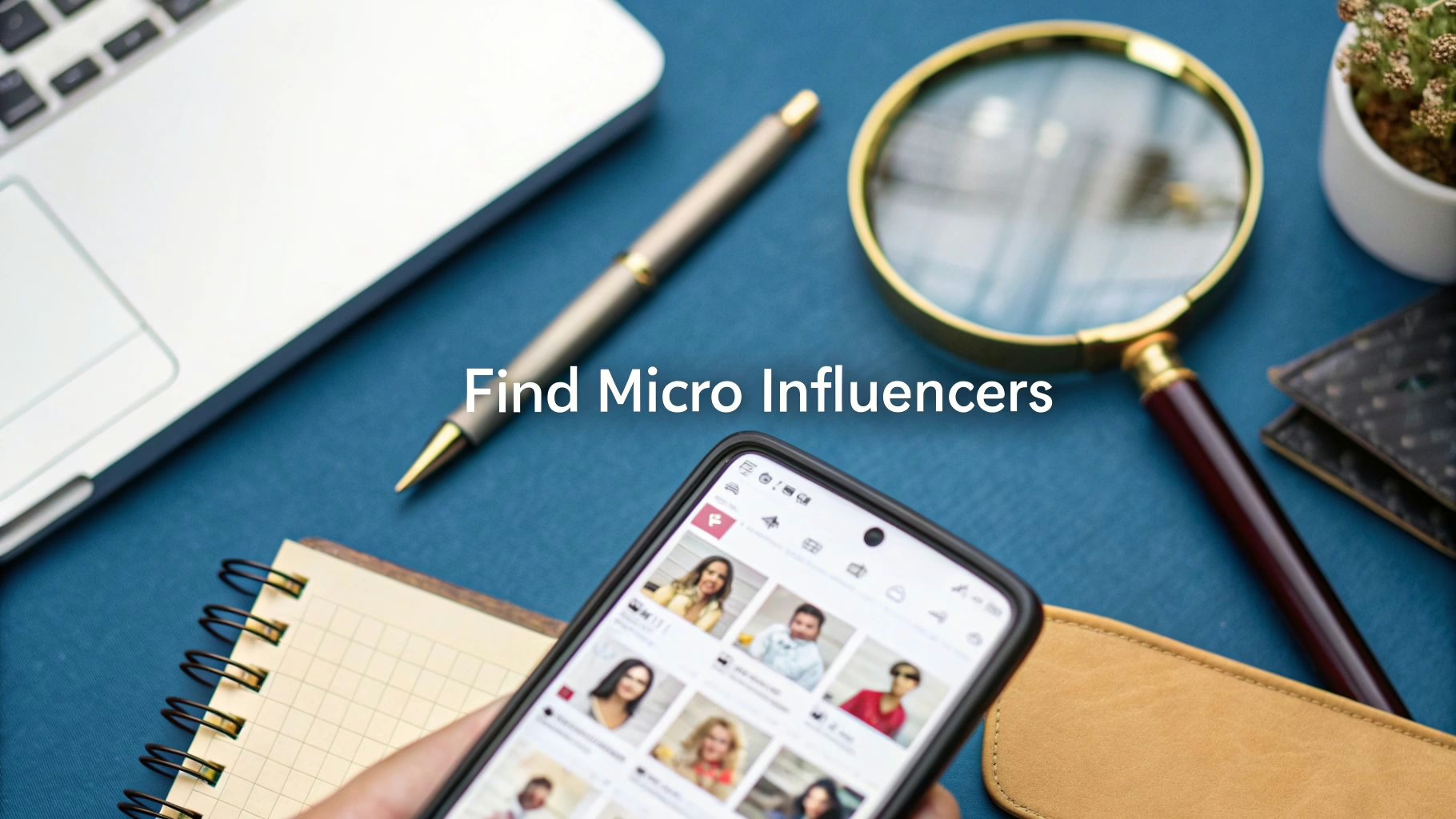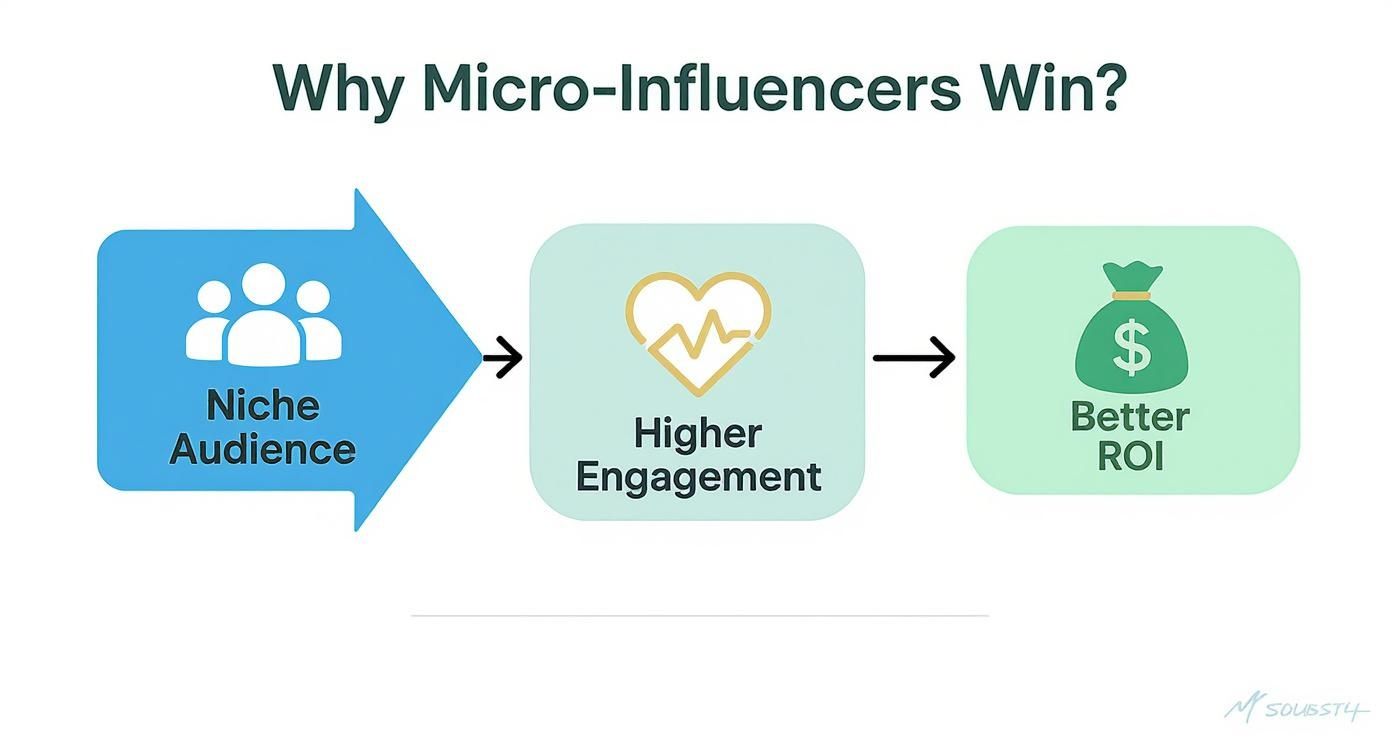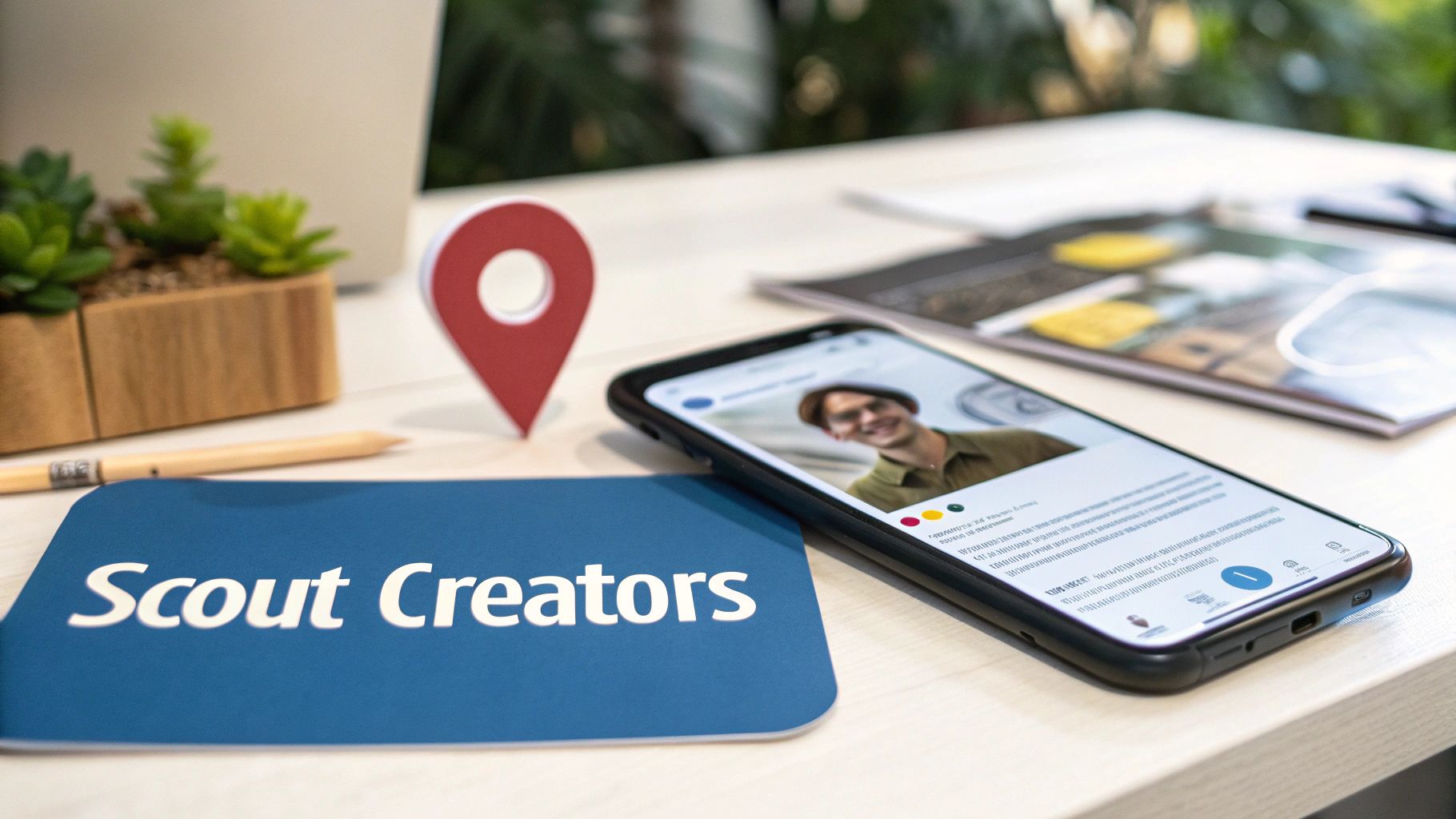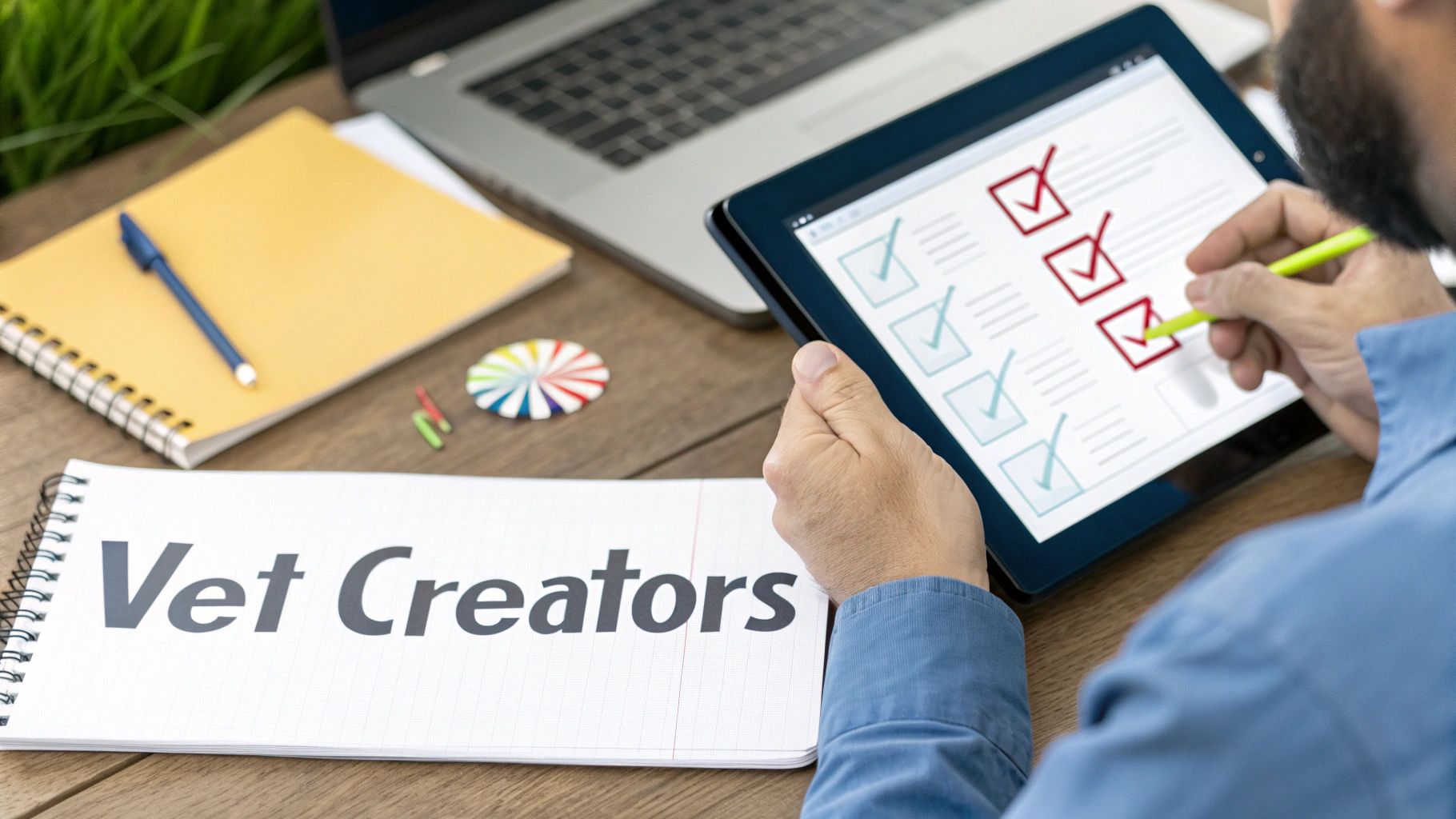Finding the right micro-influencers for your brand means looking for creators with 10,000 to 100,000 followers whose audience is a perfect match for what you sell. The real trick is to stop chasing big, flashy numbers and start focusing on creators who have built genuine trust with their community. That’s where you’ll see the highest engagement and, ultimately, a much better return on your investment.
Why Micro-Influencers Are a Smarter Bet
Before we get into the nitty-gritty of how to find these creators, let's talk about why they're often the smarter choice. It’s easy to get mesmerized by follower counts in the millions, but the most potent marketing power often comes from the smaller, dedicated communities that micro-influencers build. Their followers don't see them as untouchable celebrities; they see them as peers, which makes their product recommendations feel more like a tip from a trusted friend.
That authenticity is exactly where brands find their edge. When a micro-influencer partners with you, the promotion feels like a natural part of their content, not a jarring ad. This leads to far more meaningful interactions and a much higher chance of turning followers into actual customers.
The Power of Niche Authority
Micro-influencers are the specialists of the creator world. They've carved out a space for themselves by going deep on a specific topic, whether that’s sustainable fashion, vegan baking, or retro gaming. Because of this focus, they build an audience that shares that same passion.
This gives them incredible authority. When they recommend a product, it carries a lot of weight because their followers know it's coming from a place of real expertise.
By partnering with a niche authority, you aren't just buying exposure; you're borrowing credibility. Your product is instantly validated in the eyes of a highly targeted and receptive audience.
Unpacking the Engagement Advantage
The numbers don't lie: as an influencer's follower count goes up, their engagement rate usually goes down. Micro-influencers are the exception to this rule, consistently pulling in much higher levels of interaction.
In fact, one analysis showed that micro-influencers generate up to 60% more engagement than macro-influencers. Their average engagement rate sits around 3.86%, while macro-influencers hover at just 1.21%. It's no surprise that 67% of brands now say they prefer working with micro-influencers—the market is clearly shifting toward quality over quantity.
For a quick breakdown, here's how they stack up:
Micro vs. Macro Influencers At a Glance
This table offers a quick comparison of key metrics, highlighting why micro-influencers often pack a bigger punch for their size.
| Metric | Micro-Influencers (10k-100k Followers) | Macro-Influencers (100k-1M Followers) |
|---|---|---|
| Average Engagement Rate | Higher (~2.5-6%) | Lower (~1-2.5%) |
| Audience Trust | High (Seen as a peer/friend) | Moderate (Seen as a celebrity) |
| Niche Authority | Very high (Specialized content) | Broad (General lifestyle content) |
| Cost Per Post | Lower ($100 – $1,500) | Higher ($5,000 – $25,000+) |
| Authenticity | Feels genuine and personal | Can feel more commercialized |
Ultimately, the higher engagement from micro-influencers means your message is far more likely to be seen, discussed, and acted on. You can dive deeper into building a solid plan in our complete guide to micro-influencer marketing.
Think of it as the difference between shouting into a crowded stadium and having a compelling conversation with a small group of people who are already leaning in to hear what you have to say.
Building Your Influencer Discovery Blueprint
Finding the right micro-influencers is a lot like casting for a movie. You wouldn't just hire any actor; you'd look for someone who perfectly embodies the character. The same principle applies here. Your search shouldn't start with a frantic scroll through hashtags, but with a solid plan—a blueprint for who you're looking for and why.
Without this groundwork, you’ll burn through time and resources on creators who look great on paper but don't actually move the needle for your brand.
Create Your Ideal Influencer Persona
The first thing I always do is get ridiculously specific about my ideal partner. Forget basic demographics for a moment. Instead, build out an influencer persona.
Think deeply about who this person is. What’s their vibe? Are they witty and sarcastic, or more educational and earnest? What does their content look like—is it minimalist and clean, or vibrant and chaotic? And crucially, what do they and their community actually care about?
Let's say you're a sustainable outerwear brand. You're not just looking for "outdoor influencers." That's way too broad. A sharp persona would pinpoint creators who actively talk about eco-conscious living, whose photography has that crisp, natural feel you want, and whose audience is more interested in gear that lasts than the latest trend. This simple exercise immediately cuts through the noise.
Get Crystal Clear on Your Campaign Goals
Once you know who you're looking for, you need to define what you want them to do. A vague goal like "increase brand awareness" is a recipe for a disappointing campaign. You need to nail down specific, measurable outcomes that will tell you if your investment paid off.
What does success actually look like for you?
- Driving direct sales? A concrete goal would be hitting a 5:1 return on ad spend (ROAS), which you can easily track with unique discount codes.
- Generating leads? Maybe success means getting a certain number of new email sign-ups through an influencer’s custom landing page.
- Boosting social engagement? You could aim for a 20% lift in user-generated content tied to your campaign hashtag.
This clarity is everything. A creator who produces stunning, cinematic content is fantastic for an awareness play. But if you need to drive sales now, you're probably better off with an influencer known for their brutally honest product reviews and "buy this, not that" style content.
This focused approach is precisely how you unlock better results.
As you can see, it all starts with that niche audience. By defining your persona and goals, you lay the groundwork for the high engagement and impressive ROI that makes working with micro-influencers so powerful.
When you define your ideal partner and what you want to achieve upfront, your search goes from a random, hopeful scroll to a targeted mission. Every choice from then on is intentional, leading you to micro-influencers who can become genuine, long-term advocates for your brand.
Uncovering Influencers on Their Home Turf
While discovery platforms are fast, there's a certain magic to finding a great micro-influencer in the wild. It’s about putting on your digital detective hat and looking for clues to find creators who are an obvious fit for your brand. Sure, these manual methods take more time, but they often lead you to the most passionate and effective partners.
This hands-on approach drops you right into the online communities where your ideal customers hang out. You get a real feel for who they trust, who they actually talk to, and who is shaping the conversation in your niche.
Go Beyond Basic Hashtag Searches
Just typing in broad hashtags like #fitness or #skincare is a recipe for endless, unproductive scrolling. The gold is in the niche community tags. These are the hashtags that show someone is a true insider, not just a casual poster.
Let's say you're a coffee brand. Instead of #coffee, you'd want to dive into tags like:
- #SpecialtyCoffee: This gets you in front of enthusiasts who are particular about bean origins and brewing techniques.
- #HomeBarista: Now you're connecting with creators who've invested in quality equipment and love showing off their skills.
- #Pourover: This is super specific. Anyone using this tag regularly has a serious passion and deep expertise.
Following these niche tags helps you quickly spot the micro-influencers who are setting trends, not just following them. Keep an eye out for who consistently shows up with high-quality content under these specific tags. This is a fundamental skill when you’re learning how to find micro-influencers who have real credibility in their space.
Analyze Your Competitors' Mentions
Want a shortcut to finding relevant creators? Go see who’s already working with brands just like yours. Head over to your competitors' Instagram or TikTok profiles and check out their tagged photos and mentions. It’s basically a public directory of creators active in your industry.
Don’t just focus on their big-name partners. Scroll through and find the micro-influencers with genuinely engaged audiences who have tagged them in posts. These creators have already shown they’re open to brand collaborations and know your market inside and out.
Think of this strategy as getting a pre-vetted list of candidates. You can immediately see the quality of their sponsored work and how their audience reacts to it, which saves you a ton of time in the vetting stage.
Look at Who Your Customers Follow
Who are your most loyal customers already listening to? Your own audience is the ultimate source of truth. Take some time to browse the profiles of your best customers—the people who are always commenting, sharing your stuff, and tagging your brand.
Look at who they’re following. Do you see certain micro-influencers popping up over and over again? If a bunch of your ideal customers are all following the same handful of creators, you've hit the jackpot. That's a sign of a massive audience overlap and a huge potential for a successful partnership. It’s a direct line to the people already influencing the people you want to reach.
Using Discovery Tools to Find Influencers Faster
https://www.youtube.com/embed/t37Xlp4qSaY
While manual searching is fantastic for finding those hidden gems, it just doesn't scale. When you need to build a roster of partners quickly, influencer discovery platforms are an absolute game-changer, saving you dozens of hours of scrolling.
Think of these tools as massive, searchable databases of creators. They’re specifically designed to help you pinpoint the right people with impressive speed. It's like switching from a flashlight to a floodlight—instead of checking profiles one by one, you can apply granular filters to narrow down a huge pool of talent. This is essential when you need to find micro-influencers who fit very specific criteria for your campaign.
Key Features to Look For in a Platform
Not all discovery tools are created equal. As you explore your options, you'll notice a few key features that separate the basic from the brilliant. A truly effective platform gives you deep, actionable data that goes far beyond a simple follower count.
Here’s what you should be looking for:
- Audience Demographics: Can you see an influencer's audience breakdown by age, gender, location, and even interests? This is critical for ensuring you're reaching your target customer, not just a random group of followers.
- Engagement Rate Analysis: A good platform calculates this for you automatically, showing you who has a genuinely active and responsive community.
- Fake Follower Detection: The best tools use smart algorithms to flag accounts with suspicious follower activity, which helps protect your investment from fraud.
- Past Campaign Performance: Some platforms even show you an influencer's previous brand collaborations and how that content performed, giving you a sneak peek at their track record.
The goal of using a discovery tool isn't just to find names faster; it's to make smarter, data-backed decisions from the very beginning. This data helps you predict a partnership's potential success before you even send the first email.
Streamlining Your Search and Outreach
The real power of these platforms is efficiency. Micro-influencers are popular because they're so cost-effective. On Instagram, for instance, they might charge between $100 and $500 per post. That’s a tiny fraction of the $5,000 to $10,000 a macro-influencer often commands. To maximize that value, you need to minimize the time you spend on manual logistics.
This is exactly why platforms like our own REACH were built—to manage this entire process seamlessly. You can use our influencer discovery tool to filter creators by niche and key metrics, then manage your outreach and campaigns all in one place.
Of course, knowing different ways of finding email addresses is still a vital skill for direct and effective outreach. By automating the more tedious parts of the process, you can focus your energy on what truly matters: building authentic, lasting relationships with great creators.
Vetting Your Shortlist and Crafting the Perfect Pitch
Finding a list of creators who look promising is a great start, but this is where the real work kicks in. Before you ever hit "send" on that first message, you have to do your homework. This vetting process is what separates a truly authentic partner from someone who just looks good on paper—and it's crucial for protecting your brand's reputation and budget.
First up, a simple content check. Go beyond just their stated niche and really dig into their tone, visual style, and the overall quality of what they produce. Ask yourself: does this person’s content feel like my brand? For example, if you're a wellness brand that champions mindful living, a creator whose feed is all fast-paced, high-energy edits is probably going to create a weird disconnect for your target audience.
Digging into Audience Authenticity
Once you've confirmed the vibe is right, it's time to verify their audience. Follower count is often a vanity metric, so you need to look for the tell-tale signs of a real, breathing community. A massive follower count paired with consistently low likes and comments is the biggest red flag out there.
Another warning sign? A comment section filled with generic, one-word replies like "Cool!" or a stream of emojis from the same handful of accounts. This usually points to engagement pods, where creators agree to comment on each other's posts to game the algorithm. While it isn't outright fraud like buying followers, it means their engagement isn't coming from a genuine audience.
To get a clearer picture, it's smart to use a specialized tool. Running a profile through a fake follower checker can quickly flag suspicious activity. It gives you the peace of mind that you're investing in a real connection with real people.
How to Craft a Pitch That Actually Gets a Reply
With your vetted list in hand, it’s time to reach out. Generic, copy-and-paste emails are the fastest way to land in the trash folder. Good micro-influencers are bombarded with dozens of pitches a week, so personalization is the only way you're going to cut through the noise.
Start by showing you've actually paid attention to their work. Reference a specific post, video, or story that caught your eye. Don't just say, "I love your content." Instead, try something like, "Your recent post about sustainable hiking gear was brilliant—I especially appreciated the point you made about waterproofing." This small detail proves you see them as a unique creator, not just another name on a spreadsheet.
Keep your initial message short and to the point. Introduce your brand, briefly explain why you think a partnership makes sense for their audience, and clearly state what you're hoping to achieve.
Your outreach email should be a conversation starter, not a contract. The goal is to show genuine interest and respect for their craft, making them want to learn more about the opportunity.
The influencer marketing world has exploded, with the global market projected to hit $32.55 billion by 2025. With 86% of marketers now investing in influencer marketing, the competition for the best micro-influencers is intense. As you can see in the latest influencer marketing benchmark report, a thoughtful, personalized pitch isn't just a nice-to-have—it's essential.
Common Questions About Finding Micro Influencers
Even with the best strategy laid out, you're bound to run into questions once you start the actual search. Let's tackle some of the most common hurdles brands face when they're figuring out how to find the right micro influencers. Getting these sorted out will help you build partnerships that last.
How Many Micro Influencers Should I Work With?
This is the classic "how long is a piece of string?" question. There's no magic number, because it all comes down to your campaign goals and your budget. Instead of getting stuck on a specific number, I always advise clients to think about building a balanced portfolio of creators.
If you're just dipping your toes in the water, starting with a group of 3-5 micro influencers is a fantastic way to begin. It's a manageable number that lets you test different content styles and personalities without blowing your budget.
Think of this first group as your R&D department. You'll get a ton of data on what kind of messaging actually connects with your ideal customer. That insight is gold, and it will make your next campaign much more effective. Remember, it's always about the quality of the partnership, not the quantity of influencers.
What Are the Biggest Red Flags to Watch For?
Vetting is probably the most important part of this whole process. Knowing what to avoid is just as crucial as knowing what to look for. A few red flags should make you stop and dig a little deeper.
The biggest and most obvious one? A huge follower count with laughably low engagement. If an account has 50,000 followers but their posts are a ghost town of likes and comments, you're almost certainly looking at a bunch of fake or inactive followers.
Keep an eye out for these other warning signs:
- Generic Comments: See a lot of "Nice!" or "Great pic!" from the same handful of accounts on every single post? That’s a classic sign of an engagement pod, where creators agree to comment on each other's content. It’s manufactured engagement, not a real audience.
- Sudden Follower Spikes: A quick check with a third-party tool can show you their follower growth over time. If you see massive, unnatural jumps, it's another indicator they've been buying followers.
- A Feed Full of #Ads: If their entire feed looks like one long-running advertisement, their audience is probably burnt out. Your message is likely to get lost in the noise, and their recommendations won't carry much weight.
Should I Pay with Money or Free Products?
This is a big one. While some creators who are just starting out might be happy to post in exchange for free products (a strategy known as product seeding), the standard and best practice is to offer fair monetary payment.
You're not just getting a post; you're hiring a creative professional for their content creation skills, their time, and the engaged audience they've spent years building.
Paying influencers fairly establishes a professional relationship from the start. It shows you respect their craft, gives you a solid foundation for clear deliverables, and almost always leads to better content and a stronger commitment to your campaign.
A hybrid approach often works wonders, especially for building long-term relationships. This could look like a flat fee for the work involved, plus a generous amount of free product. It shows you value both their professional output and their genuine excitement for what you sell. At the end of the day, payment signals a partnership; free product alone can feel purely transactional.
Ready to stop searching and start connecting? The REACH discovery engine helps you find, vet, and manage campaigns with authentic micro-influencers who are perfectly aligned with your brand. Streamline your entire workflow and prove your ROI with powerful analytics.





